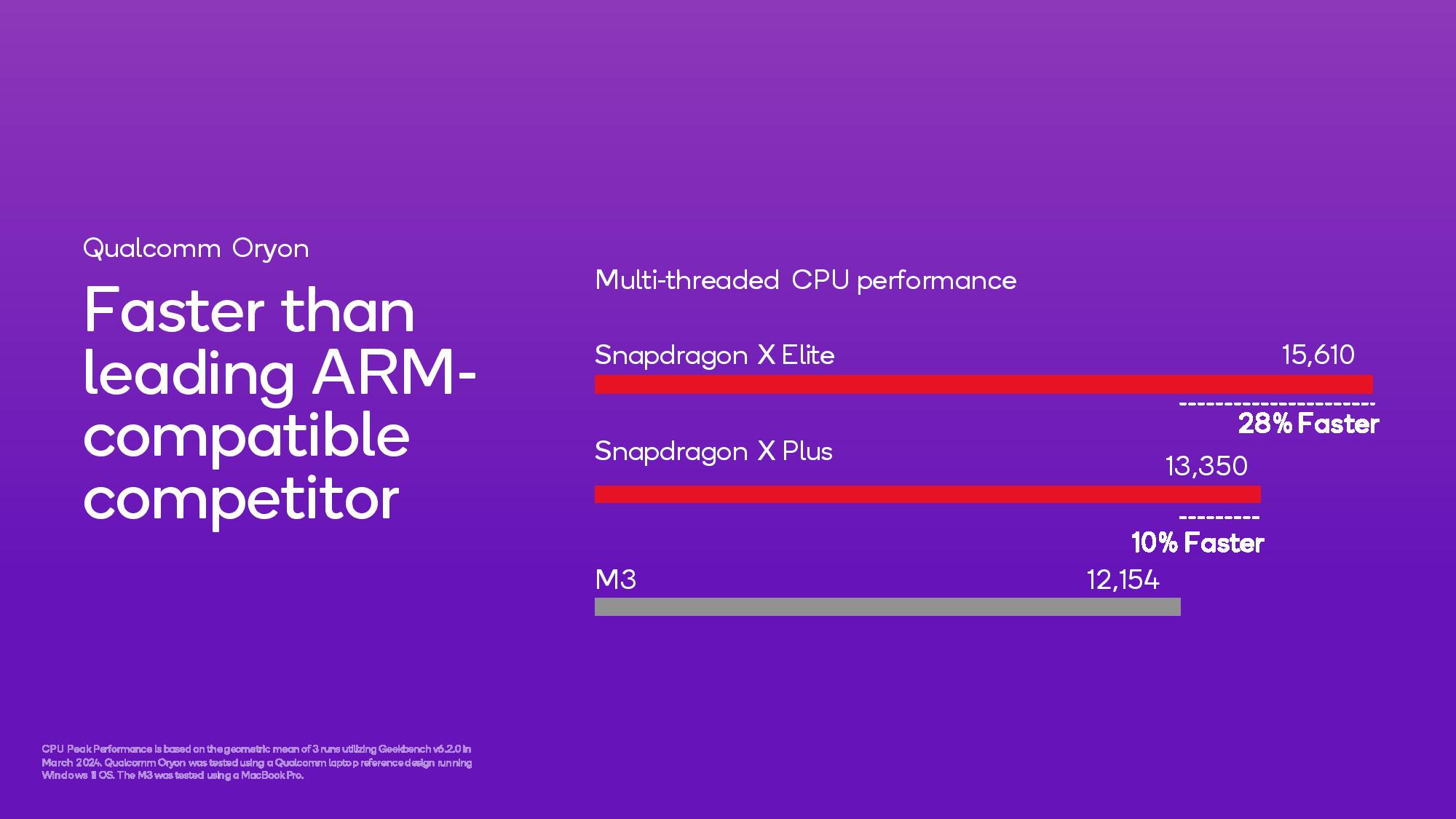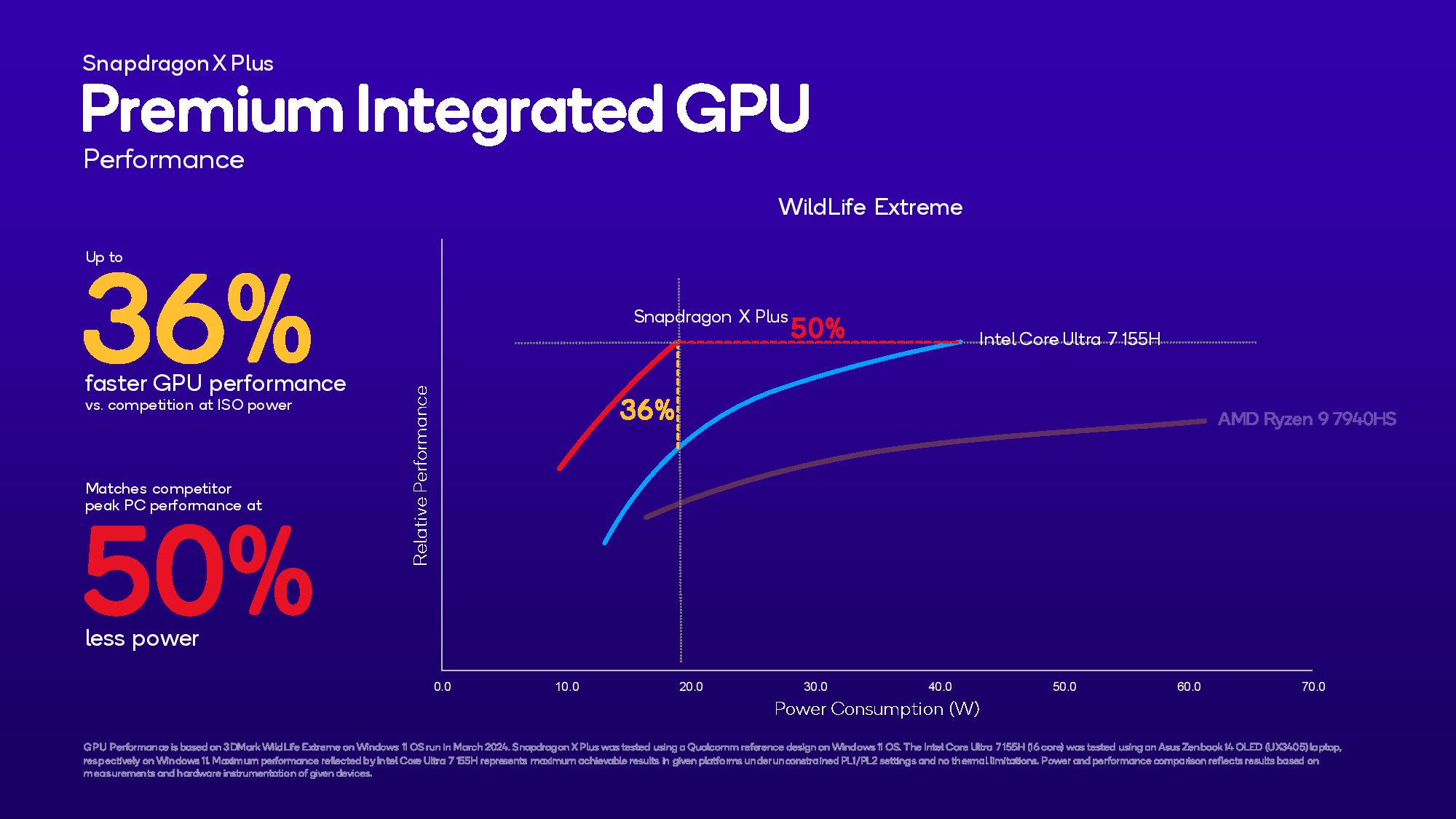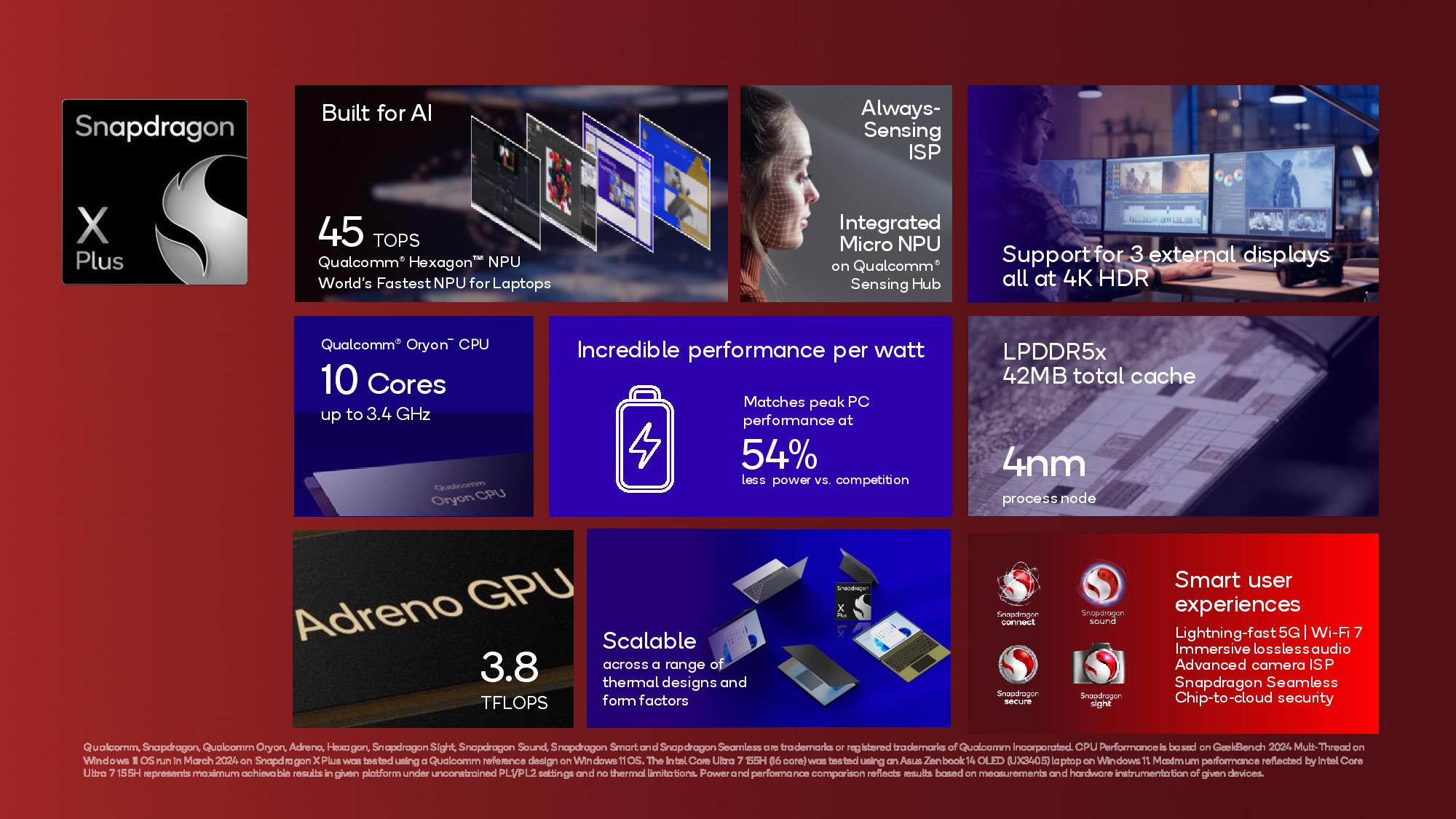Qualcomm announces Snapdragon X Plus – 10-cores is less than X Elite, but the same 45 TOPS from the NPU
A lower-end Oryon chip than Elite, destined for ultraportable designs.

Qualcomm is fleshing out its Snapdragon lineup as it approaches the promised mid-2024 launch. While we learned about the Snapdragon X Elite back in October of last year, today we're finally learning of a second SoC: Snapdragon X Plus.
(You can find more about the Snapdragon X Plus, as well as the full line of Snapdragon X Elite chips, in our Snapdragon X Series explainer.)
The Snapdragon X Plus boasts 10 Oryon cores, down from 12 on the X Elite. Currently, there is only one Plus model: the X1P-64-100, as opposed to the three options for its more powerful sibling. Unlike some of the Elite chips, there's no dual-core or single-core boost. But Qualcomm is priding itself on the fact that the Hexagon NPU offers the same 45 TOPS of performance as the more powerful chip.
Here's the rundown of the platform:
| Header Cell - Column 0 | Qualcomm Snapdragon X Plus (X1P-64-100) |
|---|---|
| CPU | Qualcomm Oryon, 10 cores up to 3.4 GHz. 42MB total cache, no single or dual-core boost |
| GPU | Qualcomm Adreno, up to 3.8 TFLOPS |
| NPU | Qualcomm Hexagon, 45 TOPS |
| Process Node | TSMC 4nm |
| Memory | Up to 64GB LPDDR5X-8448 |
| Camera | Qualcomm Spectra ISP, UP to 64MP single camera, Dual camera 2x 36 MP, 4K HDR video capture |
| Cellular Modem | Snapdragon X65 5G |
| Wi-Fi and Bluetooth | Qualcomm FastConnect 7800; Wi-Fi 6, 6E, 7, up to Bluetooth 5.4 |
And here's the specs, alongside the three Elite chips for comparison:
| Header Cell - Column 0 | Snapdragon X Plus X1P-64-100 | Snapdragon X Elite X1E-84-100 | Snapdragon X Elite X1E-80-100 | Snapdragon X Elite X1E-78-100 |
|---|---|---|---|---|
| Cores | 10 | 12 | 12 | 12 |
| Total Cache | 42MB | 42MB | 42MB | 42MB |
| Max Multi-thread Frequency | 3.4 GHz | 3.8 GHz | 3.4 GHz | 3.4 GHz |
| Dual Core Boost | None | 4.2 GHz | 4.0 GHz | None |
| TFLOPS (Qualcomm Adreno GPU) | 3.8 | 4.6 | 3.8 | 3.8 |
| NPU TOPs (Qualcomm Hexagon NPU) | 45 | 45 | 45 | 45 |
| Memory | LPDDR5X-8448 | LPDDR5X-8448 | LPDDR5X-8448 | LPDDR5X-8448 |
(A note on the memory: Qualcomm previously listed the Elite's transfer speed at 8533 MT/s, but has since changed it to 8448 MT/s.)
Qualcomm has taken to making performance claims somewhat similar to those of the Snapdragon X Elite. For instance, the company suggests the X Plus beats Apple's M3 on a multi-core performance test by 10% in Geekbench 6.2 (but didn't compare single-core, or consider the M3 Pro or M3 Max, which feature more cores).

Qualcomm is also still taking aim at the Intel Core Ultra 7 155H, but again in multi-threaded performance. On Geekbench 6.2, Qualcomm didn't share scores but said that the X Plus is up to 37% faster at normalized power and can match peak performance at 54%.
In Cinebench 2024's multi-threaded workload, Qualcomm promises up to 28% faster CPU performance at the same power, or matching Intel's performance at 39% less power.



This Snapdragon X Plus GPU chart may also show off similar performance on lower-end Elite processors, which also offer the same 3.8 TFLOPS.
We're still not getting concrete battery life numbers. To some degree, that makes sense, as that's going to depend on the full specs of the laptop the chip sits in.
Get Tom's Hardware's best news and in-depth reviews, straight to your inbox.

There is one place we got to see some single-core numbers: in a New York hands-on with some reference designs. There, a card placed next to the laptop included single-core scores for both Geekbench and Cinebench:

Qualcomm's numbers largely matched my experience, though these were preinstalled benchmarks in Qualcomm's controlled conditions. In some cases, the company's predicted numbers were lower than what I actually got. But when you compare it to the single-core numbers on the M3 in the MacBook Air, (3,082 on the 13-inch, 3,093 on the 15-inch), you see why the comparisons weren't made.
The Snapdragon X Plus is set to launch alongside the X Elite at a vague "mid-2024" release date. No specific laptops with the X Plus have been announced yet, but it's likely they'll be from the same list of companies that have agreed to support the X Elite, including Samsung, Lenovo, Microsoft Surface, and Dell.

Andrew E. Freedman is a senior editor at Tom's Hardware focusing on laptops, desktops and gaming. He also keeps up with the latest news. A lover of all things gaming and tech, his previous work has shown up in Tom's Guide, Laptop Mag, Kotaku, PCMag and Complex, among others. Follow him on Threads @FreedmanAE and BlueSky @andrewfreedman.net. You can send him tips on Signal: andrewfreedman.01
-
gg83 I curious about the market Qualcomm is going after. It has pretty steep competition in the portable market with amd and Intel, who aren't asleep at the wheel. Are profit margins enough? I guess we will see.Reply -
Notton This is less cut down than I expected.Reply
The slides would have you believe the X plus competes against the Ultra 7 and Ryzen 7, but to me it is more in line with Ultra 5 and Ryzen 5. -
HaninTH Reply
Remember that Qualcomm only "creates" the foundations for end-user products. And their products aren't only used in consumer devices. Even if this specific generation doesn't sell well, it lays the groundwork for future endeavors.gg83 said:I curious about the market Qualcomm is going after. It has pretty steep competition in the portable market with amd and Intel, who aren't asleep at the wheel. Are profit margins enough? I guess we will see.
They have enough capital in R&D and marketing to push this until a clear leader(s) is/are made.